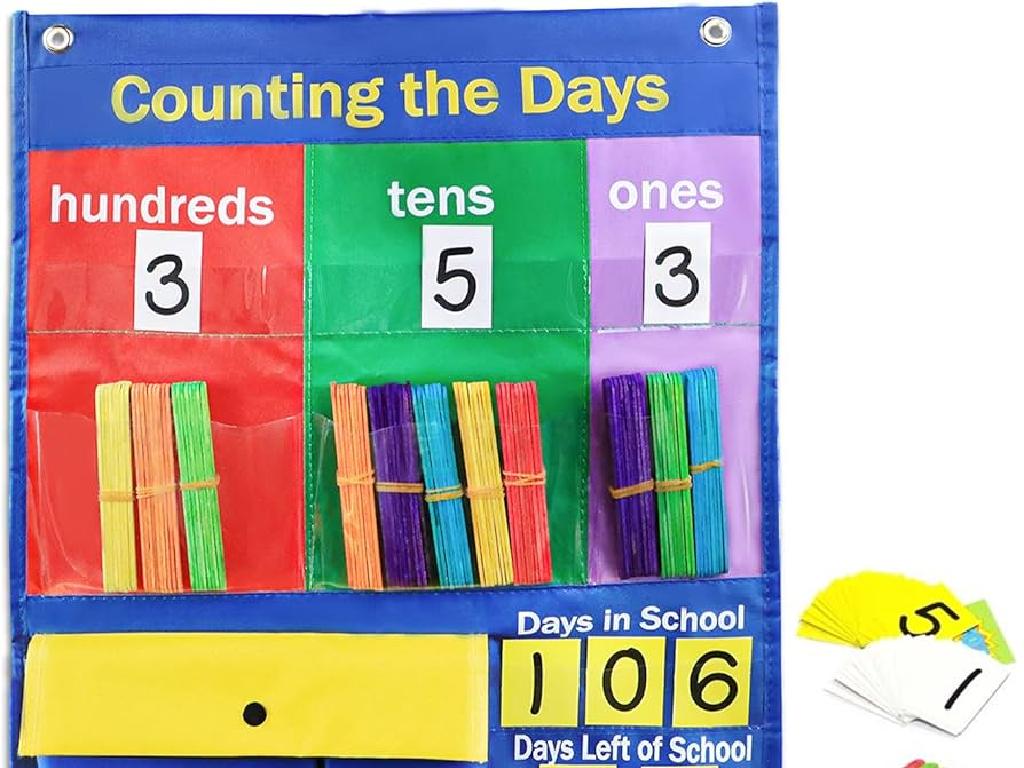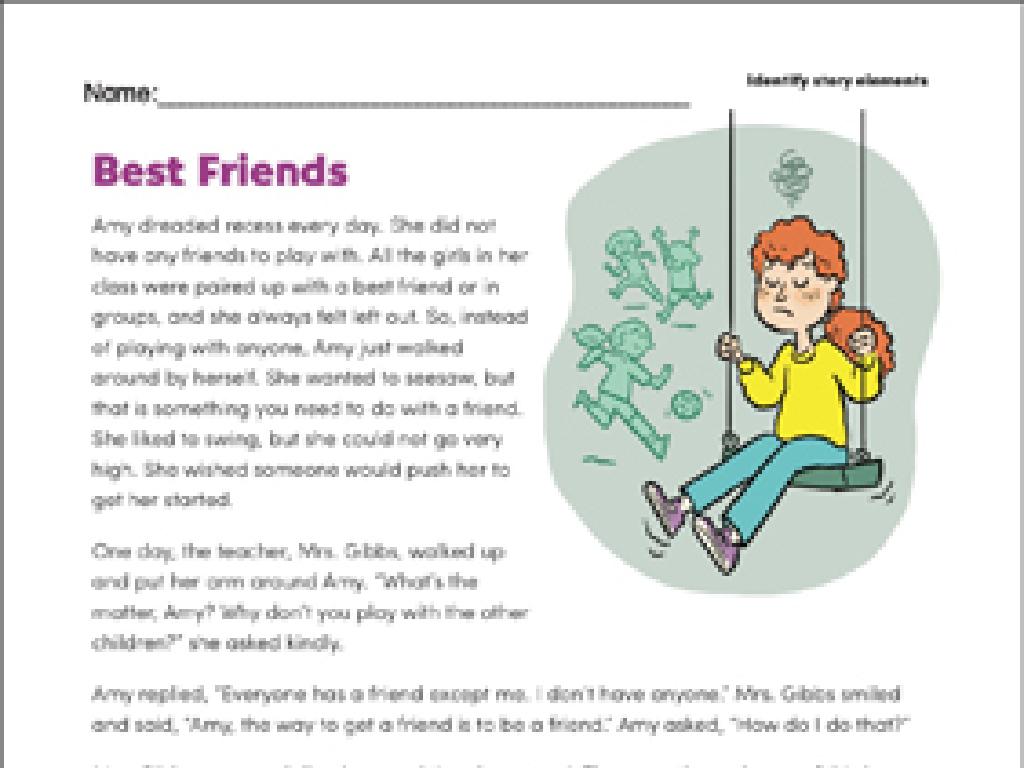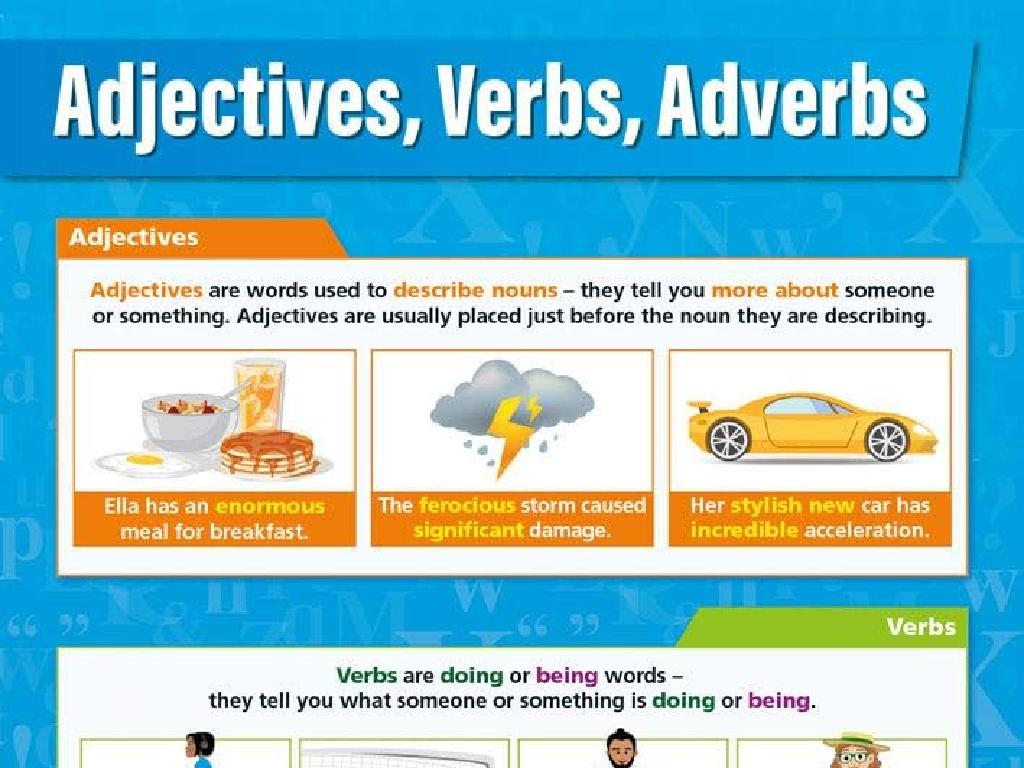Classify Figures Of Speech
Subject: Language arts
Grade: Eighth grade
Topic: Literary Devices
Please LOG IN to download the presentation. Access is available to registered users only.
View More Content
Exploring Figures of Speech in Literary Devices
– What are Figures of Speech?
– Tools that give language more color and depth
– The Power of Figurative Language
– Figurative language adds emotion and imagination
– Types of Figures of Speech
– Metaphors, similes, personification, etc.
– Enhancing Writing with Figures of Speech
– Use them to make writing vivid and expressive
|
This slide introduces students to the concept of figures of speech within the broader topic of literary devices. Begin by defining figures of speech as linguistic tools that writers use to convey meanings in a more imaginative way than literal language allows. Discuss how these devices can add emotional resonance and help readers visualize scenes or concepts. Cover several types of figures of speech, such as metaphors, similes, and personification, providing examples for each. Emphasize how using these tools effectively can enhance writing, making it more engaging and memorable. Encourage students to think of examples from literature they have read or encourage them to create their own examples.
Exploring Figures of Speech
– Define figures of speech
– Expressive language used for effect, not taken literally e.g., ‘break a leg’
– Their role in language
– Enhance expression, evoke emotion, create imagery
– Examples: Simile, Metaphor, Personification
– Simile compares using ‘like’ or ‘as’; Metaphor implies direct comparison; Personification gives human traits to non-human things
|
This slide introduces students to the concept of figures of speech, which are creative expressions used to make language more impactful and expressive. They are not meant to be interpreted literally but are used to convey emotions, visualize ideas, and enhance the beauty of language. Examples like similes, metaphors, and personification are key tools in literature that allow writers to convey complex ideas in relatable ways. Similes explicitly compare two things using ‘like’ or ‘as’, metaphors imply a direct comparison, and personification attributes human characteristics to non-human entities. Encourage students to identify these figures of speech in their favorite songs, poems, or books to understand their use and impact better.
Similes and Metaphors in Literature
– Understanding similes
– Similes compare two things using ‘like’ or ‘as’, e.g., ‘as brave as a lion’.
– Exploring metaphors
– Metaphors make direct comparisons, e.g., ‘He is a shining star’.
– Examples of similes and metaphors
– ‘Her smile was like sunshine’ (simile), ‘The world is a stage’ (metaphor).
– Effects on imagery and meaning
– These figures of speech create vivid pictures and deepen understanding.
|
This slide introduces students to similes and metaphors, key figures of speech in literature. Similes use ‘like’ or ‘as’ to draw comparisons and help readers visualize concepts. Metaphors, on the other hand, imply the comparison directly, often leading to a stronger and more immediate image or idea. Provide examples of both to illustrate how they enhance imagery and contribute to the reader’s experience. Encourage students to think of their own examples and consider how these literary devices affect their interpretation of texts. Discuss the importance of these tools in adding depth and emotion to writing.
Exploring Personification in Literature
– Defining personification
– Attributing human traits to objects or ideas
– Purpose of personification
– To create imagery and connect with readers
– Literary examples
– ‘The wind whispered through the trees’
– Analyzing personification
– Discuss how personification affects interpretation
|
Personification is a common figure of speech where non-human elements are given human characteristics. This literary device is used to create vivid imagery and foster a deeper emotional connection with the reader. By personifying objects or ideas, authors can express complex concepts in relatable terms. In this slide, we define personification, discuss its purpose, and provide examples from literature. Encourage students to think of their own examples and consider how personification can alter the way we interpret a text. Have them analyze passages to identify personification and discuss its impact on meaning and emotion in the narrative.
Figures of Speech: Hyperbole and Understatement
– Hyperbole: Exaggeration used in writing
– ‘I’ve told you a million times’ exaggerates to stress a point.
– Understatement: Presentation as less significant
– ‘It’s just a scratch’ for a large dent in a car minimizes the issue.
– Impact of hyperbole in literature
– Hyperbole can add humor or emphasize a point dramatically.
– Impact of understatement in literature
– Understatement can create irony or add a subtle, witty effect.
|
This slide introduces students to hyperbole and understatement, two figures of speech used to convey meaning in a non-literal way. Hyperbole involves deliberate exaggeration for emphasis or effect, often adding a dramatic or humorous tone to the writing. Understatement, on the other hand, intentionally presents something as less important than it is, often leading to an ironic or humorous effect. Discuss the impact of these figures of speech on the reader’s interpretation and emotional response. Provide examples from literature and encourage students to identify and create their own examples of hyperbole and understatement.
Exploring Oxymoron and Paradox
– Oxymoron: union of opposites
– ‘Bittersweet’, ‘deafening silence’
– Paradox: truth in contradiction
– ‘Less is more’, ‘I can resist anything but temptation’
– Subtlety in language
– Examples and usage
– How ‘open secret’ & ‘jumbo shrimp’ add depth to literature
|
This slide delves into the figures of speech ‘oxymoron’ and ‘paradox’, both of which play with contradictions to create meaning. An oxymoron combines two opposing words to make a new concept, often used to express complex emotions or to create a dramatic effect. A paradox is a statement that contradicts itself but still seems true, often used to provoke thought or illustrate an underlying truth. Understanding these literary devices helps students appreciate the nuances and depth of language. Encourage students to find their own examples of oxymorons and paradoxes in literature or their daily lives to deepen their comprehension.
Identifying Figures of Speech
– Tips for spotting figures of speech
– Look for exaggeration, comparison, and sound patterns
– Context is key to identification
– Words take on meaning from surrounding text
– Practice with literary excerpts
– Analyze examples from well-known works
– Recognize the impact on meaning
– Figures of speech enhance emotion and imagery
|
This slide aims to equip students with the skills to identify and understand figures of speech within literature. Emphasize the importance of looking for signs such as exaggeration (hyperbole), comparison (similes and metaphors), and sound patterns (alliteration, assonance). Stress that context is crucial; the meaning of words can change depending on the surrounding text. Provide practice by analyzing excerpts from literature, helping students see how figures of speech function in well-known works. Discuss how these literary devices add depth to the text by enhancing emotional resonance and creating vivid imagery. Encourage students to consider how the author’s choice of figures of speech affects their own interpretation of the text.
Class Activity: Crafting Figures of Speech
– Group task: Create original figures of speech
– Individual task: Write a paragraph with figures of speech
– Incorporate metaphors, similes, personification, etc.
– Share your creations with the class
– Discuss the impact on your writing
– How do these devices improve expression and imagery?
|
This activity is designed to reinforce students’ understanding of figures of speech by creating and using them in their own writing. Divide the class into small groups and have each group come up with unique examples of various figures of speech. Then, ask each student to write a short paragraph individually, using different figures of speech they’ve learned. After writing, students will share their sentences with the class and discuss how these literary devices enhance their writing by adding depth, emotion, and vividness. For the teacher: Prepare to provide guidance and examples if students struggle with creating their own figures of speech. Encourage creativity and praise effective use of language. Possible activities: one group could focus on similes, another on metaphors, and so on, or each group could try to use a range of figures of speech.
Wrapping Up: Figures of Speech
– Recap on figures of speech
– Significance in writing
– They add depth and evoke emotion
– Homework assignment
– Choose a poem or song and identify the literary devices used
– Enhance literary analysis skills
– Understanding these concepts will improve your writing and analytical abilities
|
As we conclude, remind students of the various figures of speech discussed, such as metaphors, similes, personification, and hyperbole. Emphasize how these devices enrich writing by adding color and depth, making it more engaging and expressive. For homework, students should select a poem or song of their choice and pinpoint the different figures of speech used by the author. This exercise will help them recognize the practical use of literary devices and enhance their analytical skills. Encourage them to explain how these devices contribute to the overall meaning and impact of the chosen work. In the next class, be prepared to discuss some of the examples students bring in, fostering a deeper appreciation for the art of language.






